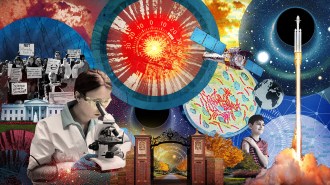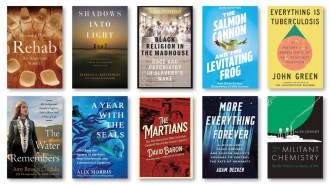Quantum connection could revitalize superstrings
- More than 2 years ago
Sometimes it’s nice to reflect nostalgically on the last couple of decades of the 20th century. You know, the era of Madonna and Duran Duran, Cheers and The X-Files, McGwire and Sosa, the Macarena, and superstring theory.
Sadly, most of those are now just memories, although I guess Madonna is still around. And actually so is superstring theory. You just don’t hear much about it these days. It’s still an active field of physics research, but the progress is technical. Nothing newsworthy.
But that could change at any time. Just last week, a new paper by Itzhak Bars suggested the possibility of a major superstring accomplishment with the potential to make strings respectable again.
Bars is a respected physicist at the University of Southern California in Los Angeles. He is known for some way-out-there ideas, like the notion that physics would be better off with two dimensions of time. Now he and USC colleague Dmitry Rychkov have proposed a connection between quantum mechanics and superstring theory. If their idea pans out, it could boost an aging theory into the list of scientific topics trending on Twitter.
If string or M-theory theory really underlies all physics, it seems that the door has been opened to an explanation of the origins of quantum mechanics from physical processes.
—Itzhak Bars and Dmitry Rychkov
News traveled more slowly in superstring theory’s early days. It started out merely as “string” theory, an attempt to explain the strong force that held atomic nuclei together. In the 1970s, though, it merged with the concept of supersymmetry. That merger spawned the notion that all of nature’s fundamental particles could be imagined as different vibration modes of one primordial type of object, a supertiny string. In this case, “string” just meant that it was one-dimensional, unlike the zero-dimensional “point” particles of standard theory.
By the mid-1980s the new superstring theory had emerged as the hottest theoretical breakthrough since quantum mechanics, mainly because it seemed to show a way that quantum mechanics itself could be merged with Einstein’s general relativity. For the first time, physicists had a unified theory that could accommodate both Einstein’s explanation for gravity and the quantum explanation for particles and other forces.
There were some snags in the strings, though. For one thing, to make the math work you needed several additional dimensions of space. Instead of a four-dimensional universe — three space, one time — you needed something like 10 or 11. But that was a mere detail.
Another early problem was that there seemed to be more than one superstring theory — different mathematical versions of the basic idea. That seemed odd. If superstring theory offered the one true final theory describing all of fundamental physics, how could there be more than one? But in 1995 Edward Witten showed that the various string theories were all just different views of a deeper theory — he called it M theory. String theory merely offered various different descriptions of the same subatomic elephant.
There was one other little hitch, too. Nobody knew how to test to see whether superstring theory (or M theory) was actually correct. Writing down a theory is one thing, figuring out whether it accurately describes nature is something else.
Please do not, however, let anybody tell you that superstrings are therefore not scientific. Sure, it’s hard to imagine ever detecting them directly with any technology that politicians would be willing to pay for. Superstrings are too small to probe with any atom smasher you could imagine building on Earth. But just as the existence of atoms could be deduced from indirect effects (Brownian motion, for instance), there are ways that superstrings could leave signs in nature that scientists could eventually decipher.
For now, though, superstring theory lacks the sort of dramatic demonstration that propels radical theories into prominence, such as Einstein’s famous precise prediction of how much starlight would be deflected when passing by the sun as measured during a solar eclipse. But perhaps some different sort of accomplishment could elevate superstring’s status. Such as one proposed in the new paper by Bars and Rychkov.
They point out that when string theory was developed, everybody assumed quantum mechanics was correct (which it is) and designed string theory to observe the quantum rules. But suppose, just for the fun of it, that you tried to build string theory without any quantum restrictions. Bars and Rychkov work out how to do that in a simplified version of string theory, specifically a version when the strings are “open” (not closed to make a loop).
In string theory, the common interactions between fundamental particles that physicists study are described as strings joining or splitting. In analyzing the details of the splitting and joining process, Bars and Rychkov found that the basic rules of quantum mechanics naturally emerge. In other words, you don’t need to assume quantum mechanics to find string theory — it’s the physics of strings that makes the world quantum mechanical.
For decades, explaining why nature observes the mysterious rules of quantum physics has perplexed physicists everywhere. Nobody could explain why those rules worked. The connection between string physics and the quantum math may now lead the way to an answer.
“This link suggests that there is a deeper physical phenomenon, namely string interactions, underlying the usual … rules of quantum mechanics, thus providing a possible explanation for where they come from,” Bars and Rychkov write. “If string or M-theory theory really underlies all physics, it seems that the door has been opened to an explanation of the origins of quantum mechanics from physical processes.”
Of course, so far the analysis is just for a “toy model” of string interactions, involving just two particles. And nobody knows for sure whether M theory really does underlie all of physics. But if a theory comes along that explains why quantum mechanics is right, it’s a theory worth taking seriously.
“If this view holds up … then the concept we discussed here for string interactions being the source for quantum mechanics would boost the credibility of string theory as a fundamental theory,” Bars and Rychkov assert.
On top of all that, the string-quantum connection suggests an intriguing insight into the nature of reality. Quantum physics is notorious for implying the existence of multiple realities, as articulated in the “many worlds” interpretation of quantum mechanics. Superstring theory has also annoyed many physicists by forecasting the existence of a huge “landscape” of different vacuum states, essentially a multiverse comprising multiple universes with a wide range of physical properties (many not suitable for life, but at least one that is). If string interactions really are responsible for the rules of quantum physics, maybe there’s some connection between the multiple quantum realities and the superstring landscape. For fans of the late 20th century, it seems like an idea worth exploring.
Follow me on Twitter: @tom_siegfried







